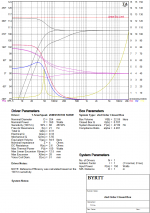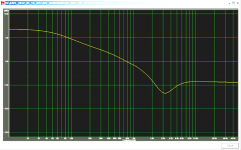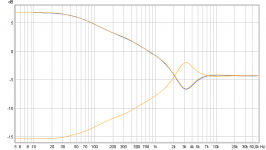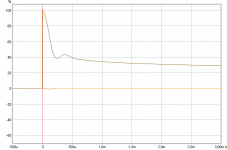For my use, JRiver made sense. Back in 2008 I was looking for a player that had good remote control capabilities and found JRiver. I've stayed with it ever since. It is, by far, the best player I've found for organizing large libraries of files. That in itself is a great benefit.
Then you discover so many good features. Bit perfect playback if you want it, 64bit floating point DSP with built in routing, filters, convolution, channel mapping, sample rate conversion, etc.
Using rePhase and JRiver DSP you can do pretty much whatever you want, with one of the best interfaces and libraries around.
Thx 🙂
BYRTT, the ID has a WDM checkbox where you said to look, but my bet is 3lld00d is right about a no go.....
Really hope you get to finish line
 because am absolut shure that if distance wasn't there and we moved my or wesayso's computer hardware into to your living room then as Pano say Rephase and JRiver DSP can do pretty much whatever you want.
because am absolut shure that if distance wasn't there and we moved my or wesayso's computer hardware into to your living room then as Pano say Rephase and JRiver DSP can do pretty much whatever you want.Silverspout - You're welcome! There are really two different animals, as far as I can tell.
APO sits in the audio stream and does EQ to everything, which is very handy.
JRiver is a media player with built in DSP. You can route other audio thru it, but it's not super simple.
APO sits in the audio stream and does EQ to everything, which is very handy.
JRiver is a media player with built in DSP. You can route other audio thru it, but it's not super simple.
BYRTT Thank you for your answer. I will try it out. Im not sure whether or not the "program" or "background", changes the sound that much. I have tried it before - But epic with the explanation. I toogle between Jriver showing/not showing all the time.....
You right the CPU role tweaks from post 1596 including up clock frequency and resolution is very small bits of change and maybe can be compared to in past make very small change to phono players cartridge weight or fiddle with tone-head adjustment on tape players or bias a power amp between B AB and A difference, we can't measure the change at all and it needs more than laptop speaker resolution to notice any change, so under test play loud to have real world bag ground noise filtered out.
Last edited:
BYRTT, the ID has a WDM checkbox where you said to look, but my bet is 3lld00d is right about a no go.
3lld00d, I think it just runs jriver, with maybe some very limited general capability.
Tried seeing what startup options are available prior to jriver loading....this is what I got...means nothing to me 😕
Grub is the bootloader, ie the thing that works out how to find the operating system to load. The W in WDM is Windows btw. Jriver on Linux is a bit half baked in my view, fine for music playback and somewhat useable for some video use but not comparable to the Windows version.
Really hope you get to finish linebecause am absolut shure that if distance wasn't there and we moved my or wesayso's computer hardware into to your living room then as Pano say Rephase and JRiver DSP can do pretty much whatever you want.
I sorted a few more things out, and now 8 channel convolution is working great !
next step is to try to double the tap count on sub and mid channels and see how performance hangs in.
I do have MC on my win10 desktop (i7), but really there's no way I'd use it for speaker management. Just can't trust a non dedicated (or online) PC.
The speakers that I've been posting measurements for, are mid 130dB boxes and any loss of band-pass processing would blow drivers quick.
Don't know what I can do about trying to route other media through the ID.
Nothing I guess. I can at least take measurements with smaart, because it is dual channel and source independent. I can just add a unfiltered output channel in DSPstudio's config file, for smaart to use as the reference source.
On the whole, I'm stoked ! Finally get to try a bunch more taps down low !
Thx again 🙂 mark
Now with the new JR id, which I've never seen before (thanks Mark!) it should be even easier. It's a very cool step forward.
Hi Pano, it is a neat product isn't it...especially the new raspberry implementations.
I've been using jriver for a while too, although I embarrassingly admit I suck at using its many capabilities .
Kinda like REW lol. (Although you did tell me some time back to hang in with REW,... that it has a fairly steep learning curve but then it's downhill sailing ...I've found that to be quite true.)
Mark,
You might be able to use the DLNA technology to get it to play from another (Windows installed) JRiver. Worth the test I suppose. The Windows JRiver would have to send the signal to the DLNA device. So if you get JRiver's WMD driver up on that PC it "should" be able to send the signal to the Linux box.
You might be able to use the DLNA technology to get it to play from another (Windows installed) JRiver. Worth the test I suppose. The Windows JRiver would have to send the signal to the DLNA device. So if you get JRiver's WMD driver up on that PC it "should" be able to send the signal to the Linux box.
So I have a question about phase in general.
So I use rephase for car audio . I have a few different configurations for different "moods"
(I'm not always a purist) there are times I like to party and crank up the two 15s with 1200w up and boogie .
I'm pretty sure I read somewhere that equal loudness is different for in car vs. room and makes it so you need a lot more bass to equal what you hear is as loud in a car. Maybe that's why it's so fun idk BUT , when I want to have exaggerated bass is there a way to at least make it linear and sound correct with the rest of the system.
Usually when bass is 10db louder than midbass it causes it to be slightly lagging or de-tuned like.
Using delays only fixes some of the response but not all of it (frequency depending)
Would I be able to import a measurement and make it flat or should it follow the downward curve from sub to mid-bass. Basicly should I try make it follow the shape of responce or just be flat ? What will sound correct ?
Thanks in advance
So I use rephase for car audio . I have a few different configurations for different "moods"
(I'm not always a purist) there are times I like to party and crank up the two 15s with 1200w up and boogie .
I'm pretty sure I read somewhere that equal loudness is different for in car vs. room and makes it so you need a lot more bass to equal what you hear is as loud in a car. Maybe that's why it's so fun idk BUT , when I want to have exaggerated bass is there a way to at least make it linear and sound correct with the rest of the system.
Usually when bass is 10db louder than midbass it causes it to be slightly lagging or de-tuned like.
Using delays only fixes some of the response but not all of it (frequency depending)
Would I be able to import a measurement and make it flat or should it follow the downward curve from sub to mid-bass. Basicly should I try make it follow the shape of responce or just be flat ? What will sound correct ?
Thanks in advance
I am using rephase to generate filters for miniDSP HD 2x4. The output format is 32 bit IEEE754 mono.
The problem is that when i import the filters to the DSP, all frequency settings are consistently doubled. So a 2000Hz LP-filter is now a 4000Hz LP-filter. Obviously i can work around it, its just really weird.
Oabeieo: Try shaping your frequency response around the noise floor of your running car. So if your engine drones at 50-80Hz, boost 50-80Hz. The perceived "slowness" of a extremely bass-heavy system cant be prevented, other then if you raise your midbass as well.
The problem is that when i import the filters to the DSP, all frequency settings are consistently doubled. So a 2000Hz LP-filter is now a 4000Hz LP-filter. Obviously i can work around it, its just really weird.
Oabeieo: Try shaping your frequency response around the noise floor of your running car. So if your engine drones at 50-80Hz, boost 50-80Hz. The perceived "slowness" of a extremely bass-heavy system cant be prevented, other then if you raise your midbass as well.
Last edited:
I am using rephase to generate filters for miniDSP HD 2x4. The output format is 32 bit IEEE754 mono.
The problem is that when i import the filters to the DSP, all frequency settings are consistently doubled. So a 2000Hz LP-filter is now a 4000Hz LP-filter. Obviously i can work around it, its just really weird.
Oabeieo: Try shaping your frequency response around the noise floor of your running car. So if your engine drones at 50-80Hz, boost 50-80Hz. The perceived "slowness" of a extremely bass-heavy system cant be prevented, other then if you raise your midbass as well.
Your doubling in frequency is because your not using 96k in rephase
Doing what your doing surly wil cause some audible pre-ringing.
And your right about the file type except you forgot to add .bin
Re: yeah I have tryed that and it works pretty good , I usually prefer perfectly flat responce for critical listening 20-20k and for sq listening 1.8db slope down
But like I said for party mode the subs go up about 15-30db and the horns actually see some real power and total spl gets into the 130s
So it's not really a noise floor problem I have used several different layers of sound dampening, the car is new and quiet , I was just curious about how phase should look when it's has so much gain over the rest of system. I only switch to that configuration a couple time a month usually my kids like it more than I 😛
So I was just wondering if amplitude goes up should phase follow it?
when the bass is up that loud it gets noticeably de-tuned almost to the point it's out of key completely like a g# is a f~ or what have you (in the sub bass 20-60hz) I suspect it's excess group delay and am wondering what approach would be correct for that type of listening.
Hi Oabeieo,So I have a question about phase in general.
So I use rephase for car audio . I have a few different configurations for different "moods"
(I'm not always a purist) there are times I like to party and crank up the two 15s with 1200w up and boogie .
I'm pretty sure I read somewhere that equal loudness is different for in car vs. room and makes it so you need a lot more bass to equal what you hear is as loud in a car. Maybe that's why it's so fun idk BUT , when I want to have exaggerated bass is there a way to at least make it linear and sound correct with the rest of the system.
Usually when bass is 10db louder than midbass it causes it to be slightly lagging or de-tuned like.
Using delays only fixes some of the response but not all of it (frequency depending)
Would I be able to import a measurement and make it flat or should it follow the downward curve from sub to mid-bass. Basicly should I try make it follow the shape of responce or just be flat ? What will sound correct ?
Thanks in advance
Are you sure that you know what is "flat" in your car?
It is very easy to use any target if you know true response of your system - how far it is from flat.
The "true" means - you can create eq which is following measured response, use it in your system and it removes any colorings and does not make new ones.
.....I'm pretty sure I read somewhere that equal loudness is different for in car vs. room and makes it so you need a lot more bass to equal what you hear is as loud in a car.....
I'm no specialist here but maybe this sim into WinspeakerZ can help you a bit, all three curves is same woofer in Qtc 0,7 box, two of them is box with and without baffle-step loss and the curve that extends down to DC potential is "Model Auto Cabin Response". Imagine there is lot of good info to study out on web to get it right, also imagine if car doors are open or if car is convertible that it would heavy influence low freguency curve.
Attachments
Last edited:
..... I was just curious about how phase should look when it's has so much gain over the rest of system.....
Post 1634 also present the close to linear phase curve (non lagging Purple) down to DC potential with the low end gain boost gained from auto cabin response, but in reality when that sub is summed relative to rest of systems audio band there's a real filter XO point that needs to be calculated into the final systems phase curve if XO is minimum phase type.
Last edited:
Thanks to BYRTT for pointing to the Jeff Bagby`s work "Baffle Diffraction and Boundary Simulator" in the post :
http://www.diyaudio.com/forums/full...eaker-correction-networks-25.html#post4568489
It is showing how serious is the problem.
But the actual loudspeaker`s performance must be measured in a car environment and it is possible in very accurate way right now.
Such target curve is showing excellent results for years and years. Including European EMMA finals ...

http://www.diyaudio.com/forums/full...eaker-correction-networks-25.html#post4568489
It is showing how serious is the problem.
But the actual loudspeaker`s performance must be measured in a car environment and it is possible in very accurate way right now.
Such target curve is showing excellent results for years and years. Including European EMMA finals ...
Attachments
Thanks Raimonds : )
If any car audio interested want that curve find a dirty traced manual made copy attached as Rephase settings file plus one curve in reverse.
If any car audio interested want that curve find a dirty traced manual made copy attached as Rephase settings file plus one curve in reverse.
Attachments
Hey thanks guys!
Some new reading for Sure and great ideas on where to start.
This is the kind of feed back I just can't get on the car forums. And if I'm lucky to get this kind of feed back it's riddled with ego ...😛
Wow so I have a whole different approach to try now
And to reply Raymond's , can you elaborate on what you said about not being sure what true flat is? I suspect that you know something that I don't because I don't know what true flat is I just go by what my RTA is telling me and my measurements . Is there something I'm missing ? Keep in mind not sure if you caught all the posts before , this is tune I'm trying to accomplish for my teenagers.
After reading some of these replys I'm not sure they (the kids) are that far off now.
That in car curve looks pretty dramatic, I will try!
Some new reading for Sure and great ideas on where to start.
This is the kind of feed back I just can't get on the car forums. And if I'm lucky to get this kind of feed back it's riddled with ego ...😛
Wow so I have a whole different approach to try now
And to reply Raymond's , can you elaborate on what you said about not being sure what true flat is? I suspect that you know something that I don't because I don't know what true flat is I just go by what my RTA is telling me and my measurements . Is there something I'm missing ? Keep in mind not sure if you caught all the posts before , this is tune I'm trying to accomplish for my teenagers.
After reading some of these replys I'm not sure they (the kids) are that far off now.
That in car curve looks pretty dramatic, I will try!
Thanks Raimonds : )
If any car audio interested want that curve find a dirty traced manual made copy attached as Rephase settings file plus one curve in reverse.
Thanks for posting that!
Oh btw everyone I'm still sorta in the noob phase, Some of this I'm still very much figuring out.
So I tryed making a curve that resembles that one. Sounds pretty good! A lot thicker than what I've been listening to and I don't have to turn it up so loud to hear detail.
So it's starting to make a lot more sence now. it looks like phase is inverse of the responce. On that graph. I took some measurements and the sub already sorta does that. The sub QTC is qtc .5 (I don't have speaker measuring abilities) so I rely on what winisd tells me. But in car response.....no clue...
Well maybe this can be a big learning experience for me....so this is what I've been doing as of lately and maybe y'all can tell me what I'm doing wrong.
( sorry I am not big into screen shots but I can post some of requested)
So.... first I use RTA and make responce flat on each driver with crossovers off
I set my limits 2 oactaves up and down of my target crossover point so I'm not trying to blow up speakers but get a good measurement of the driver. Than I either manually or use auto eq in rew set my output peqs to make driver flat 2 oactaves past it's crossover (s). I generally don't use any boost in peq) Than i take another averaged set of measurements after eq applied and export that into rephase , than I apply my crossovers And make any phase eq adjustments I can with limited taps. Than find by trail and error which rephase option gives me the best predictor. Than I generate a filter and load it into the HDs. One by one speaker by speaker I go through all the speakers and I am using close mic to speakers. (Within 12") . Take a few more measurements and validate the crossover and stop band interference and use peq to turn down the strays. Than I set delays on speakers to match the longest filter. Than I listen and set levels. Than I add delays to closer speakers etc and do some measurements.
At this point I would do listening position gloabal input peqs across all drivers and shape responce.
Only close mic measurements phase makes sence even if I set my t=0 the phase in REw just goes straight down. :/ I can't seem to make it look flat in REw. In REw I can make minimum phase look flat. And it usually hugs the magnitude very close. So this is where I'm a noob . How do you get plain "phase" in REw to not go straight down? I have been under the assumption that I should be looking at minimum phase is that wrong? IIRC if I zoom way way out phase looks more flat. I'm not sure if that's how I should be looking at it though🙁
When I import a listening position measurement into rephase it's clustered with reflections. No matter what I do with acoustic timing it's all over the place. . So I don't know if rephase view mode is phase or minimum phase. So that's why I can't grasp this last part of how to read some of the measurements. I think it's because my room is so reflections.
So when I look at my sub phase for example for it to look like BYRTTs first picture what rew setting is that. Minimum phase?
Thanks for all yalls time and advice.
Last edited:
If your in room measurements are cluttered with reflections, you have the same problem as does everyone else. In REW, click the "IR Windows" button on the left end of the row above the main screen. A menu pops up. Check the box for "add frequncy dependent windows" set width in cycles to 5 and then click "apply windows" The windowing gates out the reflections. Read the help on that to understand better.🙂
- Home
- Design & Build
- Software Tools
- rePhase, a loudspeaker phase linearization, EQ and FIR filtering tool




